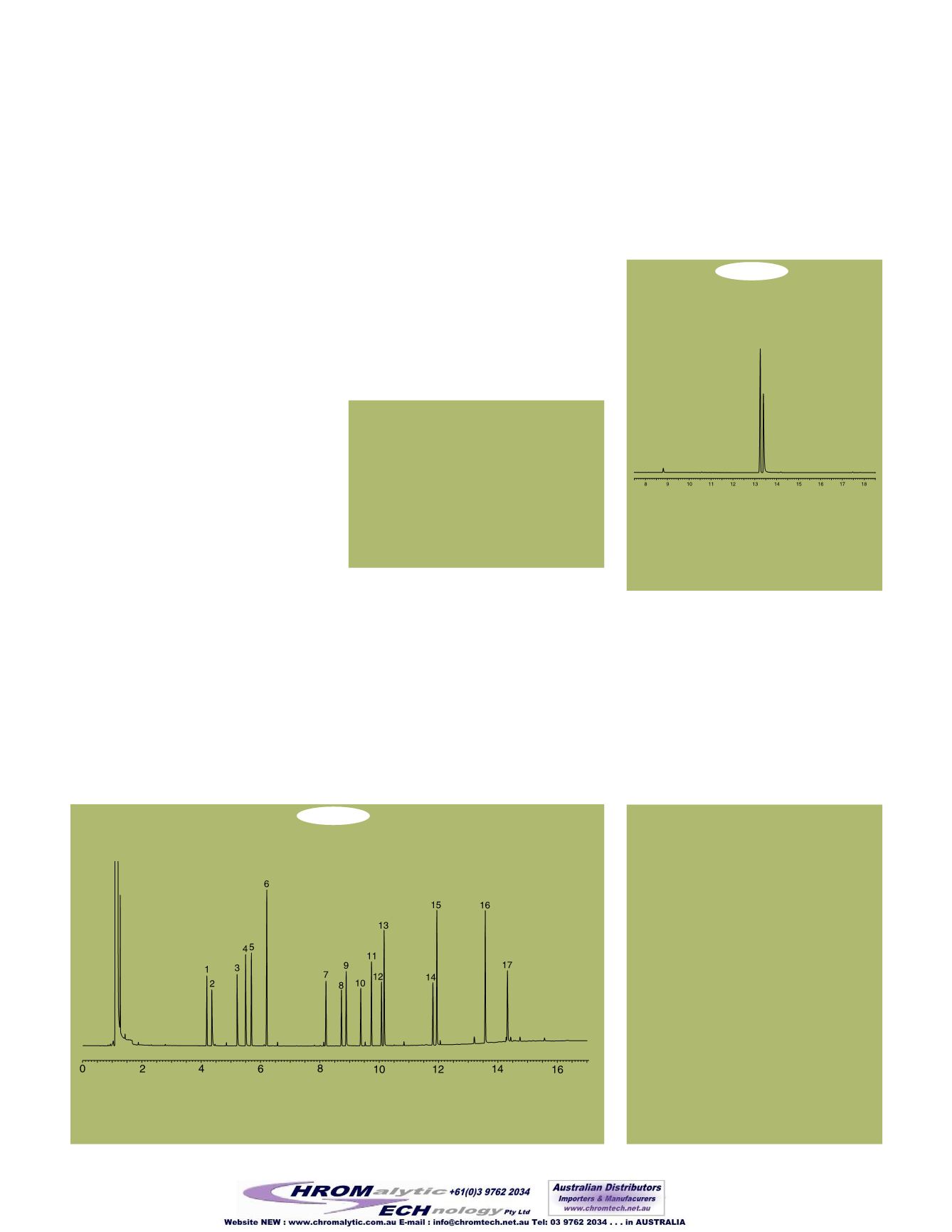

• 10 •
www.restekcorp.com800-356-1688
by Rebecca E. Wittrig, Ph.D., Food, Flavor, and Fragrance Innovation Team Leader;
and Kevin MacNamara, Ph.D., Irish Distillers Ltd.*
GC Analysis of Acids, Esters,
and Other Flavor Components in
Distilled Liquor Products
Stabilwax
®
-DA GC Column—Part I
✔
High thermal stability (250°C) and solvent rinsibility result in long
column lifetime.
✔
Optimized configuration reduces analysis time by 4-fold.
✔
Low bleed for accurate quantitation.
Part I: The Separation
Distilled liquor products contain a wide range of
volatile and non-volatile compounds in an
ethanol/water matrix. The most abundant fusel
alcohols and esters can be determined by gas chro-
matography (GC) with a simple split injection,
which also minimizes the amount of matrix ethanol
and water transferred to the column. However,
many additional trace fatty acids and their esters—
often used to indicate quality of alcoholic beverages
such as whiskey and rum—cannot be determined
by this approach. Because the concentrations can
vary widely, splitless injection techniques with some
type of preconcentration step usually are necessary
to analyze fatty acids, esters, and other flavor com-
pounds.
Large ranges of volatility and acidity for the compo-
nent list make quantitating them in a single separa-
tion difficult to accomplish. The Stabilwax
®
-DA col-
umn, a bonded polyethylene glycol (PEG) phase, is
excellent for analyzing alcoholic beverage samples
(Figure 1). Using this column, flavor compounds in
distilled liquor products can be quantitated in a
single splitless injection. An optimized configuration
of 30m, 0.18mm ID, 0.18µm allows significantly
reduced analysis times. To improve the peak shape
and reproducibility of acidic components in these
samples, an acidic functionality has been added to
the backbone of the PEG stationary phase. This
results in less adsorption of free fatty acids and,
thus, significantly less peak tailing. Also, because of
the inertness of this stationary phase towards acidic
components present in the sample, greater repro-
ducibility and longer column lifetimes are possible.
One of the critical pairs in the GC analysis of esters
and acids in distilled liquor products is caproic
acid and ethyl laurate. These components can be
difficult to resolve on standard Carbowax
®
-type
columns. This is especially true if peak tailing or
broadening occurs, or if one component is present
at a significantly higher concentration. The
Stabilwax
®
-DA column achieves baseline resolution
of these two compounds within a reasonable analy-
sis time of 30 minutes (Figure 2).
*Irish Distillers Ltd., Bow Street Distillery, Smithfield, Dublin 7, Ireland
Part II
of this article will appear in the
Winter '01/’02 Advantage. We will look at
the Stabilwax
®
-DA column for alcoholic
beverage analysis. Trace-level components,
such as the ones displayed in Figure 1,
often can be used to "fingerprint" a particu-
lar type or brand of distilled liquor. The
application of this methodology to whiskey
products will be discussed in Part II.
Peak List for Figures 1 & 3
compound
conc. (ppm)
1. ethyl octanoate
100
2. acetic acid
100
3. propionic acid
100
4. isobutyric acid
100
5. decanol 3
50
6. ethyl decanoate
50
7. ethyl laurate
50
8.
cis
-lactone
100
9. 2-phenylethanol
50
10.
trans
-lactone
100
11. methyl myristate
50
12. ethyl myristate
50
13. octanoic acid
100
14. ethyl palmitate
50
15. decanoic acid
100
16. dodecanoic acid
100
17. vanillin
100
Figure 1
The Stabilwax
®
-DA column provides excellent peak shape of free fatty acids, esters, and
other flavor compounds contained in an alcoholic beverage test mix.
30m, 0.18mm ID, 0.18µm Stabilwax
®
-DA (cat.# 550752)
Oven temp.:
70 to 240°C at 12°C/min. (hold 3 min.);
GC:
ThermoQuest Trace 2000;
Inj.:
1µL splitless at conc. shown
in peak list, in ethyl acetate;
Detector:
FID;
Inj. & det. temp.:
240°C;
Liner:
4mm ID splitless liner w/wool (cat.#
20814-202.1);
Hold time:
0.5 min.;
Carrier gas:
hydrogen;
Make-up gas:
nitrogen;
Linear velocity:
28psi @ 240°C
Figure 2
The Stabilwax
®
-DA column achieves
complete resolution of caproic acid and
ethyl laurate in 30 minutes.
30m, 0.18mm ID, 0.18µm Stabilwax
®
-DA (cat.# 550752)
Oven temp.:
80 to 230°C at 5°C/min.;
See Figure 1 for complete conditions.
1. caproic acid
100 ppm
2. ethyl laurate
100 ppm
Because alcoholic beverage samples often are
injected via splitless mode, the stability of the
Stabilwax
®
-DA column when exposed to aqueous
injections is important. We verified stability by per-
forming a splitless injection of the alcoholic bever-
age test mix, followed by five 1µL injections of
water. This process was repeated 10 times, followed
by a final injection of the test mix. The final test mix
injection can be seen in Figure 3. Even after repeat-
ed splitless injections of 100% water, very little
degradation occurs in the peak shapes of the test
min.
GC_FF00500
GC_FF00525
1
2


















